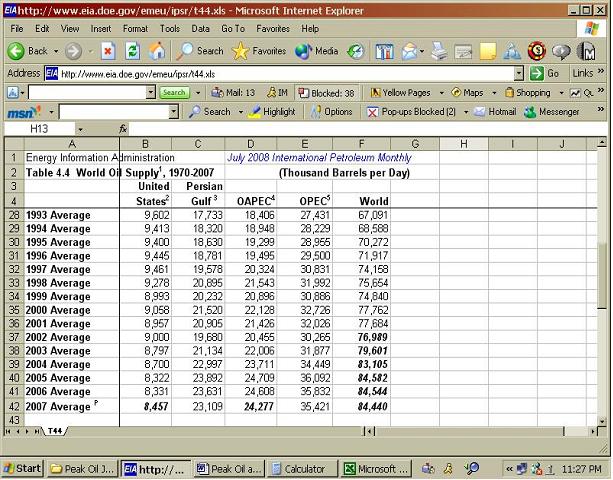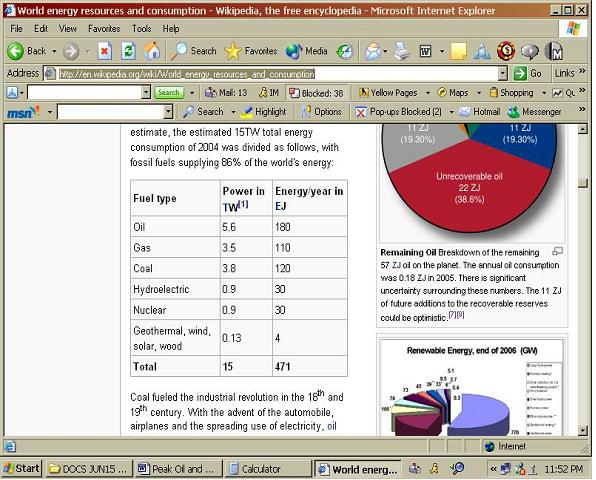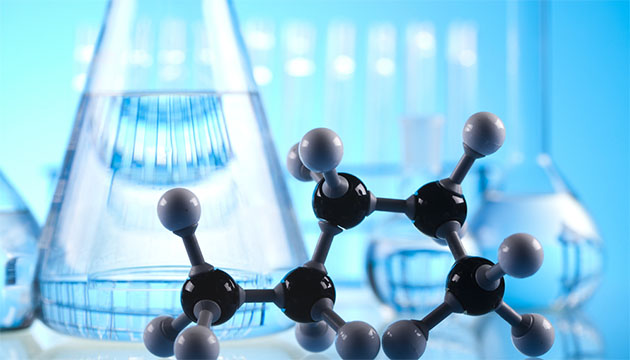The concept of peak oil is not about running out of crude oil. It never has been. A Shell geologist (M. King Hubbert) in the '50s formulated, from his years of study of oil field production, his theory of Peak Oil. He predicted, accurately, that U.S. crude production would peak between 1965 and 1970.
The actual year was 1970. If you never again read anything else about peak oil, read this.
http://en.wikipedia.org/wiki/Peak_oil
Be clear on this. It’s not about running out. We are pumping crude in the U.S. today, 38 years after the U.S. peaked. The peak comes when daily output can no longer be expanded and begins to shrink inexorably, year after year.
Best estimates are that the world started with two trillion barrels in the earth. Best estimates are that one trillion remain. Look at the largest fields ever.

http://en.wikipedia.org/wiki/Peak_oil/Table_of_largest_oil_fields
For perspective, the world today uses 85 million barrels per day. That is 31 billion barrels per year. At that rate, the one trillion barrels of estimated reserves would last 32 years until it was all gone.
But that is not the issue. The problems start when daily production cannot meet daily demand. Check the chart. Note carefully that world production has not increased significantly since 2004 and has been shrinking since 2005.
This in a world where the worldwide monotonic demand growth has been about 2%.

http://www.eia.doe.gov/emeu/ipsr/t44.xls (Excel spreadsheet)
The world is not finding enough new crude to replace the known declines, not to mention increasing production levels.
What happens with the shortfall in production? Crude prices rise. Frantic, nearly (previously) insane searches begin…tar sands; shale oil; deep, deep sea drilling; ANWR. Sound familiar?
And as a tidbit to fend off the prattle…the best estimate (shaky as all untested estimates are) for ANWR is 10 billion barrels of crude resources. On the same shaky basis, USA offshore…20 billion barrels. Together…30 billion barrels.
But that’s not the worst of it. Neither cannot begin producing for about 10 years. And either will require 20 years for full production. The bottom line is at full bore production, both included, we’d get output starting in 2018 and have 1.5 billion barrels/year until 2037. The U.S. uses 21 million barrels per day, 7.67 billion barrels per year. That’s ignoring demand growth. Not exactly crude oil freedom at 20% of our 2007 demand.
Peak oil is here. Accept it. Do your own research. Bring me facts, and then let’s debate.
Nuclear Power
Having finally accepted the fact that we aren’t going to have fossil fuels for transportation forever (and probably not at an acceptable cost within 10 years), what can we do?
Let’s start with reviewing the world’s energy use. Check here to get educated. http://www.bp.com/productlanding.do?categoryId=6929&contentId=7044622
And this: http://www.iea.org/Textbase/npsum/WEO2007SUM.pdf
And finally here, to which I’ll refer. http://en.wikipedia.org/wiki/World_energy_resources_and_consumption This is a terrific resource. Don’t fail to read this. It’s the single best summary I’ve ever seen for the world’s energy use.
And this for the USA:
http://en.wikipedia.org/wiki/Energy_use_in_the_United_States
WORLD USE (2004)

I’ll turn these numbers into percentages (2004 numbers):

Our discussion here is about transportation…cars, trucks, trains and planes. They run on crude oil derivatives. Now let’s suppose that crude oil derivatives get too expensive to use (peak oil). Worst case…not available or affordable for transportation. Now look at the table above.
A full 40% of our energy supply would be gone. Let’s eliminate the presently unrealistic or non-cost-effective transportation sources…coal, hydro, nuclear (in the vehicle), renewable (in the vehicle). Hydrogen fuel cells will never work. Google it.
We are left with natural gas or electricity (however generated). Unfortunately, natural gas is widely used to heat homes and factories. And, natural gas is a feedstock for many critical industrial processes…fabric, glass, steel, paint, and plastics and of utmost importance, fertilizer. http://msucares.com/crops/fertilizer/index.html and http://en.wikipedia.org/wiki/Natural_gas
Running vehicles on natural gas is not only possible, but is being pursued. Unfortunately, its value in other areas make its use for transportation a very dicey proposition. Our grandkids would say in horror…”you burned it up!!??” http://en.wikipedia.org/wiki/Natural_gas It’s not our best choice.
So we are left with electricity, however generated. Look at the table above and mentally add 40% to each source of electricity that is left.
Coal 23%==>63%.
Nuclear 8.1%==>48.1%
Renewables 3.3%==>43.3%
Which is most technically feasible to scale? Coal? Carbon emissions…cap and trade…coal cleanup costs…coal is an unlikely source of electricity to nearly triple. And, coal has important uses in the manufacture of metals and metal products. http://www.eia.doe.gov/cneaf/coal/quarterly/html/t28p01p1.html
Renewables? If only! But scaling up by a factor of 13 is a formidable challenge. Not in the next twenty years. Not even in the next 50 years.
Nuclear? The USA has 104 operating nuclear power plants. Scaling up by a factor of six would require 624 plants, or 520 new ones to replace crude oil totally. They cost about $4-5 billion each. For this, we would pay $2.34 trillion. We import 10 million barrels of crude every day. We send out of the USA $438 billion annually for purchased crude oil.
We’d pay off the nukes in five years and four months, and then we are ahead more than $1,430 per year for every citizen in America. http://www.eia.doe.gov/pub/oil_gas/petroleum/data_publications/company_level_imports/current/import.html
Of course it’s not quite so simple…I know that. It’s way oversimplified. But it does place a yardstick on the economics if we could make electric cars (I want a Tesla) powered by nuclear power plants sending electricity into every garage. http://www.umich.edu/~gs265/society/nuclear.htm The Michigan University case for nuclear power. It’s a good summary.
Now, of course, the objections to nuclear power plants.
1. What are we going to do with all of the spent fuel?
2. How about Chernobyl?
3. How about Three Mile Island?
4. Won’t uranium run out anyhow?
5. What if a plane, terrorist or otherwise, hit a nuclear plant?
6. Can’t terrorists steal the fuel rods or the waste and kill us?
7. What about uranium mining causing environmental pollution?
8. Who is going to put up $2.34 trillion?
9. Who is going to insure these plants in case they blow up?
10. What’s the construction cost?
11. What’s the generated price per kWh?
12. What’s the decommissioning cost?
13. How long to get some going?
14. How about the temperature increase in the cooling water?
15. Where’s the cooling water going to come from?
16. How much CO2 and other greenhouse gasses are emitted to build the plants?
17. How long would it take to build them all?
I am sure there are more, but educate yourselves on your own particular bitches. http://en.wikipedia.org/wiki/Nuclear_power This is an important article. If you are going to read only one, this would be it. In reflection, this balanced article covers nearly every point I am trying to address.
What Are We Going to Do With All of the Spent Fuel?
Let’s start with the saddest observation of all. There is no need to have this problem. France, which produces 79% of its electricity with nuclear plants, does not. France, and almost everyone else, reprocesses their fuel. We do not because Jimmy Carter (a nuclear engineer, for Lord’s sake) decided in 1977 that it was too “dangerous” because of the fear of nuclear proliferation (which has continued nonetheless). http://www.chemcases.com/nuclear/nc-13.htm Reagan reversed Carter in 1981 but reprocessing has never been initiated. Nonsense. Read this to learn the reality of proliferation. http://www.argee.net/DefenseWatch/Nuclear%20Waste%20and%20Breeder%20Reactors.htm
It must be noted that even without reprocessing, the radioactivity in spent fuel rods drops by 99.9% in 40 years. This is in stark contrast to the “thousands of years” screech of activists. (Waste Management and Disposal) And, with modern processing technology, the high level wastes produced to be stored total about 3 cubic meters per billion kilowatts of electricity produced. (4% of the volume of un-reprocessed fuel rods). This site contains a very thorough analysis of used fuel storage and used fuel reprocessing and storage. http://www.world-nuclear.org/info/inf04.html
Waste is a concern. It is being handled, and has been for years, by France among others.
The Yucca Mountain storage facility has been (and is now being) delayed by Nevada activists. This is unfortunate, but not catastrophic. Since the USA cannot now reprocess, the spent fuel rods simply sit in ponds near the nuclear power plants, cooling and losing radioactivity. The volume is not large and the process is simple.
Simply storing encapsulated spent fuel rods in Yucca would fill it up in about 10 years. If reprocessing were to occur, the Yucca Mountain facility would be sufficient until 2100, at least. http://www.anl.gov/Media_Center/News/2005/testimony050616.html
How About Chernobyl?
The reactor incident at Chernobyl (April 26, 1986) was the worst in the history of nuclear power reactors. But perspective is needed. First, less than 57 deaths resulted. Second, a comprehensive study estimates that about 4,000 more might die from radiation exposure. Greenpeace estimates many more will die, but after 20 years, no one has.
Long-term cancer effects are wildly disputed. Cancers occur all of the time. Tying specific cancer deaths to Chernobyl is an exercise in futility.
http://www.guardian.co.uk/environment/2005/sep/06/energy.ukraine
http://www.timesonline.co.uk/tol/news/world/europe/article563041.ece
http://www.msnbc.msn.com/id/12368859/
But however many perished is not exactly on point. The reactor did not have a containment structure like those required for U.S. plants, although it was shielded with concrete covers. Had a U.S.-style containment structure been in place, no radiation would have escaped and no one would have died.
Next, the idiocy of the activities that led to the accident is nearly beyond belief. A series of stupid, rule-breaking steps performed by engineers/experimenters with no knowledge of reactor physics (not plant operators) led to the sad result. An intelligent summary can be found at this link. http://www.pbs.org/wgbh/pages/frontline/shows/reaction/readings/chernobyl.html
No reactor designed like Chernobyl has ever been, or ever could be, licensed in the United States. http://www.world-nuclear.org/info/inf06.html http://www.cravenspowertosavetheworld.com/content/view/14/30/
How About Three Mile Island?
Let’s start with the obvious. No one died. No one was injured. So what did happen? It was a partial core meltdown. The accident description is very long and detailed. The bottom line is that the reactor vessel maintained integrity and contained the damaged fuel. Read details here: http://en.wikipedia.org/wiki/Three_Mile_Island_accident
As a consequence of this March 28, 1979 accident, major new safety requirements were instituted for both equipment and training. Such an accident, the only one ever in the USA, could never again occur. http://www.world-nuclear.org/info/inf06.html and http://www.cravenspowertosavetheworld.com/content/view/14/30/
Won’t Uranium Run Out Anyhow?
At the rate of current usage, it is estimated that the world’s known resources (principally in Canada, USA and Australia) will last about 85-100 years. http://en.wikipedia.org/wiki/Uranium_mining Uranium may also be collected from ocean water for about $109/lb. using the newest technologies. This source is essentially limitless.
Uranium reserves have never been as widely sought as, say, crude oil. With an increased world price, it is likely a great deal more could be found and produced. Moreover, thorium, with three times the abundance of uranium, could be used as an alternative. http://nuclearinfo.net/Nuclearpower/WebHomeAvailabilityOfUsableUranium
It must be noted that the cost of uranium is not important in the cost of electricity produced. http://nuclearinfo.net/Nuclearpower/WebHomeAvailabilityOfUsableUranium
Finally, the technology has been demonstrated that uses no net uranium…the breeder reactor. This reactor technology has not superseded conventional reactor design as the cost of uranium is too low to make this technology competitive. http://en.wikipedia.org/wiki/Breeder_reactor
What if a Plane, Terrorist or Otherwise, Hit a Nuclear Plant?
A fundamental question. What if a plane were to hit the plant? Short answer: nothing. http://www.nei.org/newsandevents/aircraftcrashbreach/
And in the extremely unlikely case of a large airplane hitting a containment structure, precautions have been developed to prevent any harm to residents of the surrounding areas. http://www.ecolo.org/documents/documents_in_english/terrorist_attack_on_nuclea.htm
But make no mistake. If a pilot with sufficient skill and a large enough plane hit the right spot on the button, a real mess could occur. Not likely, but theoretically possible. http://www10.antenna.nl/wise/terrorism/112001gre.html
Can’t Terrorists Steal the Fuel Rods or the Waste and Kill Us?
This notion is fundamentally nonsense. It would be practically impossible, physically, to steal spent fuel rods. But if one were to do so, what would he do with it? This topic is hardly worth discussing. For openers, one would need a uranium enrichment plant!http://www.brookings.edu/articles/2002/spring_weapons_cravens.aspx
What About Uranium Mning Causing Environmental Pollution?
A lot of dirt is moved to mine uranium. Does this pollute the environment? For openers…sure. So does mining anything else. Get a handle on this. What is being mined is not significantly radioactive. Think of it as being about as radioactive as granite. And these mines are as strictly controlled as anyone could considerable reasonable. http://www.world-nuclear.org/info/inf25.html At the end of the day, these mines are no worse, nor better, than mining for lead.
Who is Going to Put Up $2.34 Trillion?
Of course, we cannot build 520 plants immediately. The most optimistic target would 20 per year, starting in five years. Worldwide, 36 are under construction today.
The capital required would be $90-100 billion per year for 26 years beginning about 2012. This kind of funding must be borrowed. But lenders today are very hesitant to pony up such funds. The delays or bans imposed by safety or system requirement changes during construction, by political demagoguery, by activism and legal maneuvering can cause enormous delays and cost overruns.
In fact, the Long Island Lighting Shoreham plant was completed, brought to criticality and then decommissioned (at a cost of $5.6 billion) because of activism and politics.
Utilities and their prospective lenders must be guaranteed that once started, these plants can be completed as scheduled. And until a few successful example plants have been built, the government will probably have to guarantee the loans. There is precedent for this. http://scitation.aip.org/journals/doc/PHTOAD-ft/vol_59/iss_2/11_1.shtml
Who is Going to Insure These Plants in Case They Blow Up?
This is a real problem. http://answers.yahoo.com/question/index?qid=20080822093610AA087EH The almost infinitesimal probability of a serious incident, coupled with the astronomic cost of such an incident, make this a no-way deal for an insurer. The easy money from the premiums, coupled with a company-extinguishing cost of an incident, are not the stuff of which insurance companies are made.
Extremists don’t make the task any easier. http://www.foeeurope.org/activities/Nuclear/pdf/2007/Face_your_demons.pdf
It’s pretty clear that asking conventional insurance companies to take on this task is not realistic. There is, of course, only one answer. The “gubment” (and all of us taxpayers) are the only fallback position. Does this make sense? Should we all be on the hook for the once-in-a-lifetime event?
In the final analysis, we really don’t have a choice. We must have this energy source. If we don’t get it, our lives will change profoundly, in ways we won’t like. Will we do it? For sure. Read here for information about the Price-Anderson insurance coverage. http://files.asme.org/asmeorg/NewsPublicPolicy/GovRelations/PositionStatements/13013.doc
What’s The Construction Cost?
It is difficult to calculate the cost of a nuclear power plant. What is to be included? Increasingly, four “all-in” costs have been included. Construction, operating, waste disposal and decommissioning are included. It is claimed that the construction costs are or can be declining due to growing experience in economy-in-volume. Questionable.
The most optimistic claims are by Westinghouse for its advanced PWR reactor at $1000/kW. The GE AWBR plants in Japan (2000) came in at about $2000/kW. The Chinese Nuclear Power Industry has won contracts for plants of their own design for $1300-1500 per kW.
I’m willing to settle on $2000/kW. Overruns have been a persistent part of construction history, usually due to arbitrary delays because of safety regulations. France has been able to avoid these problems by settling on a standard, pre-approved design.
Operating costs are easier to pin down. The utilities that operate these plants are audited and have a firm grasp on these costs. At present, the operating costs are about 1.68 cents per kWH, including 0.2 cents per kWH for waste disposal and decommissioning costs.
It is important to note that the cost of the uranium fuel contributes only 0.05 cents per kWH to the operating cost of the plant. Plants are very expensive to build, but cheap to operate, relatively speaking. http://nuclearinfo.net/Nuclearpower/WebHomeCostOfNuclearPower This link is comprehensive for the costs of nuclear power plants.
What’s the Generated Price Per kWh?
This is a thorny question. What costs are to be included? If we try to include everything (the carrying costs of capital, operating costs, fuel and decommissioning) we find experience varies. The worst case was historical plants. http://www.phyast.pitt.edu/~blc/book/chapter10.html The cost can be profoundly impacted by regulatory authorities. Massive capital loans are required. Hold the project up for a year for regulatory “re-evaluation” can tack on billions.
But getting past history, the best estimate now is that electricity can be generated, all-in, for 3.8-4.0 cents per kWh. This is accounted for in a non-traditional way. It includes amortizing the cost of building the plant and the cost of decommissioning it.
This is about 20% less than coal plants (our present cheapest alternative) measured in the same way.
What’s the Decommissioning Cost?
Relatively speaking, it’s trivial. Best estimates are about $0.05/kWh generated. http://www.world-nuclear.org/info/inf02.html http://www.phyast.pitt.edu/~blc/book/chapter10.html Coal plants are cheaper to decommission. However, their higher fuel costs swamp this advantage.
And note that the historical estimates of a nuclear plant’s life has been about 40 years. The recent relicensing of plants makes clear that the arbitrary conservative life span was…well, conservative. They last more than 60 years.
How Long to Get Some Going?
Building a nuclear power plant is not a weekend project. It takes years to get approved, and years to construct. Presently, the approval process is about five years. This is changing.
http://www.ens-newswire.com/ens/mar2007/2007-03-09-04.asp
http://www.fpl.com/environment/nuclear/approval.shtml
http://www.energy.gov/4854.htm
After the approval comes the actual construction. Typically, another five years. http://www.phyast.pitt.edu/~blc/book/chapter10.html So realistically, I expect a new plant cannot be finished before 2018 at the earliest. Since some are already underway, we may see the first coming online by 2015.
How About the Temperature Increase in the Cooling Water?
It is important to note that the cooling requirements for a nuclear power plant are no different from those of a coal-fired plant. The heat generated to make steam to turn the turbine must be removed and the steam condensed back into water.
-If the power plant is next to the sea, a big river or large inland water body it may be done simply by running a large amount of water through the condensers in a single pass and discharging it back into the sea, lake or river a few degrees warmer and without much loss from the amount withdrawn. That is the simplest method - "once-through" cooling. The water may be salt or fresh. Some small amount of evaporation will occur off site due to the water being a few degrees warmer.
-If the power plant does not have such abundant water, it may be done by passing it through the condenser and then using a cooling tower, where an updraught of air through water droplets cools the water. Occasionally an on-site pond may be sufficient for this. Normally the cooling is chiefly through evaporation, with simple heat transfer to the air being of less significance. The cooling tower evaporates up to 5% of the flow and the cooled water is then returned to the condenser. The 3 to 5% or so is effectively consumed, and must be continually replaced. This is the main type of recirculating cooling.
The best situation is for the plant to be located beside a large body of cold water. This permits “once-through” cooling. The cold water is simply drawn in, used for recondensing the steam, and returned to the source. Limits are typically imposed on the temperature of the returned water (typically 30 degrees Celsius or 86 degrees Fahrenheit). http://www.world-nuclear.org/info/cooling_power_plants_inf121.html
Where a large body of water is not available, more advanced techniques are used (e.g., cooling towers using recycled water). This subject is complex. Read the link. http://www.nucleartourist.com/us/prairie.htm Bottom line…temperature increase in the cooling water is a non-issue.
Where’s the Cooling Water Going to Come From?
Covered above. Read the link for a complete discussion.
Fresh water is a valuable resource in most parts of the world. Where it is at all scarce, public opinion supports government policies, supported by common sense, to minimise the waste of it.
Apart from proximity to the main load centers, there is no reason to site nuclear power plants away from a coast, where they can use once-through seawater cooling. Coal plant locations need to have consideration for the logistics of fuel supply (and associated aesthetics), with over three million tonnes of coal being required per year for each 1000 MWe plant.
If any thermal power plant - coal or nuclear - needs to be sited inland, the availability of cooling water is a key factor in location. Where cooling water is limited, the importance of high thermal efficiency is great, though any advantage of, say, supercritical coal over nuclear is likely to be greatly diminished due to water requirements for FGD.
Even if water is so limited that it cannot be used for cooling, there is the option of dry cooling (with extra cost) for either coal or nuclear plants. Alternatively the plant can be sited away from the load demand and where there is sufficient water for efficient cooling (accepting some losses and extra cost for transmission).
Nuclear power plants should not be disadvantaged relative to coal by water use considerations. If water is very scarce, dry cooling can be used, though this has some cost and efficiency penalty.

How Much CO2 and Other Greenhouse Gases are Emitted to Build the Plants?
In a sense, this is a silly question. A running nuclear power plant emits essentially no greenhouse gases. The most prevalent alternative, a coal-fired plant, is a major generator of such gases. Building a major power plant, nuclear or coal, generates essentially the same energy requirements and greenhouse gases. Mining coal or uranium are also similar. The sixty year operating life and its attendant emissions are far more important than the construction period.
There are little or no greenhouse gas emissions from using uranium to generate electricity. According to the U.S. Department of Energy and the Energy Information Administration report "Voluntary Reporting of Greenhouse Gases 1997" (published June 1, 1999), the single most effective emission control strategy for utilities was to increase nuclear generation. The same report states that “Nuclear generated electricity avoids almost 700 million metric tons of carbon dioxide per year in the U.S.”
But let’s compare building them. It is sometimes stated that nuclear power plants can supply electricity with zero emissions of greenhouse gases. In fact, consideration of the entire fuel cycle indicates that some greenhouse gases are generated during their construction and decommissioning and by the preparation of fuel and other materials required for their operation. This follows from the use of fossil fuels in the preparation of materials and during the construction and decommissioning of the plants.
Let’s examine the life cycle studies of several different kinds of power plants. Greenhouse gases generated by fossil fuels during the preparation of fuel and heavy water used by operating CANDU power plants are estimated. The total greenhouse gas emissions from CANDU nuclear plants, per unit of electricity ultimately produced, are very small in comparison with emissions from most other types of power plants. http://www.computare.org/Support%20documents/Publications/Life%20Cycle.htm
The estimation of precise quantities of greenhouse gases produced is an enormous, if not impossible task, because of the vast number of integrated operations that go into the construction and operation of a nuclear plant. Each component of a plant also has a life cycle, which depended to some degree on fossil fuels. The complexity is compounded by the differing choices of processes and energy sources used to undertake a particular operation. These processes may vary dramatically in their energy efficiency per unit output and the primary energy source that drives them.
The separation of heavy water, a material component of heavy water reactors, from the light water with which it is mixed in nature provides a simple example. The separation can be achieved using a heat source. At one extreme the heat could be derived from fossil fuels such as coal or oil. Another extreme would derive the heat from a nuclear power plant. This approach greatly reduces the amount of carbon dioxide (CO2) generated per unit of the heavy water reactor component. Heavy water for CANDU reactors is now obtained by using nuclear energy to supply heat.
The topic is extremely complex. There is no point in my detailing it here. Simply read the link. Bottom line…it’s irrelevant to the nuclear argument.
How Long Would it Take to Build Them All?
Basically covered earlier. These plants (depending on the source and size) cost from $3-6 billion each. That cost is certain to go up. The component materials and construction/engineering skills required are in short supply and are in demand all over the world, not only for nuclear plants but for similar coal and gas powered plants.
Notwithstanding our desire or available capital there is only so much world-wide capacity to build. Today there are 36 plants under construction. As the demand is great, this may well represent the world’s ability to produce new plants today.
This is not a business you get into over a long weekend. After Areva, Toshiba, Candu and GE/Hitachi there is not much else available. http://www.spiegel.de/international/spiegel/0,1518,460011,00.html http://www.fpl.com/environment/nuclear/approval.shtml
Sucking this up, the USA will be exceedingly fortunate to be able to build 20 plants each year starting in 2013. That number is, unfortunately, unlikely. We are not the only country wanting them. India wants 19, China wants 63. I’d predict 10 per year is about the maximum we could build.
This is not as bad as it seems. Remember, the need for these plants is posited on adding to our traditional electricity growth needs or even replacing coal plants, and then providing the added electricity needed for the electric cars of the future.
None of this is going to happen rapidly. The timeline for these adds/changes is also in the tens of years. Nothing will happen next Thursday…it will take decades.
Bottom line…I believe we will be building about 10 new plants every year for the next 50 years. We need so many more.
About the author: "Donnernv", a pseudonym, is a regular contributor to Motley Fool CAPS. He's an active investor, and has spent 15 years studying energy, macroeconomics and investing. He graduated Yale BEE Electrical Engineering, and has a joint MIT/Harvard Business MBA. Before retiring, he worked for McKinsey and Company, and founded two companies — Canberra Industries (Nuclear research electronics), now owned by AREVA, and Commerce Register (which provides data processing for direct marketing industry).



























































